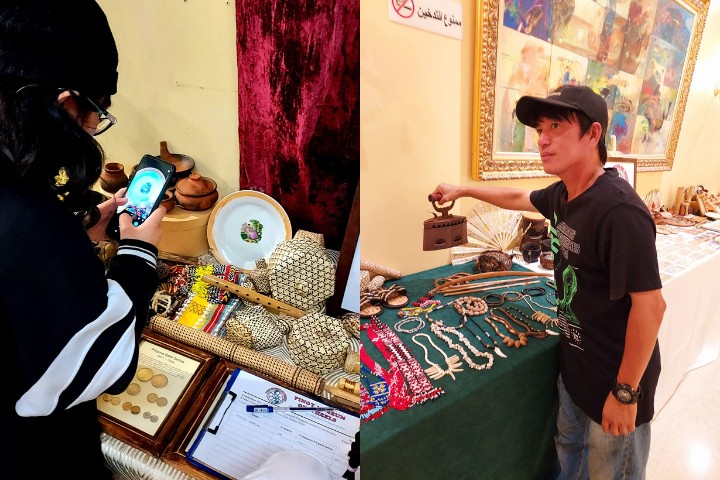A proud overseas Filipino has been making waves in the Middle East through his unique way of promoting Philippine history, culture and arts.
Brian “Ibrahim” Asinas Mendoza, through his personal project and initiative, the Pinoy Museum on Wheels (PMOW), has been traveling across the Kingdom of Saudi Arabia to showcase his extensive collection of Philippine memorabilia, such as old banknotes and coins, postal stamps and cards and other cultural artifacts.

Mendoza recalled how he was involved in different community service organizations and events before the inception of his project.
He said he was inspired by the Embassy on Wheels, which would visit Filipino communities in the Kingdom to provide government services.
“I came up with the idea to do a museum that travels to different places, same as the embassy,” Mendoza said in an online correspondence with the Philippine News Agency.
The traveling museum started on Aug. 23, 2018 and he said it was only supposed to be a one-day exhibit of his collections, but he eventually decided to launch it as a mobile museum.
During the launch, it gained the support of his fellow advocates for the preservation of Philippine culture and arts and the Philippine Embassy in Saudi Arabia, under the leadership of then-Philippine Ambassador to Saudi Arabia, Adnan V. Alonto.
Free of charge
The PMOW holds free exhibitions in various schools, hotels, and malls and during events of different Filipino communities and organizations in Saudi Arabia.
Mendoza was also the first Filipino to exhibit in the Cultural Palace of Saudi Arabia which allowed the museum on wheels to gain the recognition of other nations beyond Saudi Arabia through their representatives.
When asked how he keeps the PMOW operations afloat, Mendoza said: “Since the PMOW is my advocacy, all expenses, fees, and maintenance costs come from my own pocket.”
He said as he thanked his good friends who volunteer their time and energy to help him set up the exhibits.
Mendoza also receives donations from private individuals in the form of collectible items that can be added to the exhibition.
Mendoza reminisced about the unforgettable comments he received from exhibit-goers: “unique, the only one.”
Most Filipinos would say, “Naalala ko ang aking kabataan sa Pilipinas (I remember my youth in the Philippines)”.
“Hearing different positive comments and (seeing) happy reactions from their faces are the payment for all my efforts in this advocacy,” Mendoza said.
Collection
His love and passion for collecting items started when he was in high school, where he would gather unique stones from his province of Oriental Mindoro.
“During my high school years, I also started to collect used stamps and postcards,” he added.
Aside from traveling to different places in the Philippines to acquire specific items for the museum, he would also participate in online auctions and biddings.
“My favorite pieces are Philippine money (banknotes and coins). It is quite challenging to collect, especially the guerilla notes during the Second World War. During that time, there were specific kinds of money in some provinces, such as Cebu, Bohol, Palawan, Mountain Province, Misamis, Mindanao, and Apayao. Some of that money is very rare and very hard to find,” he said.

Other notable items in his collection include an antique clothes iron that was heated using coal and an old Philippine-made Lucky Plate, a now collectible item that was once a common freebie with purchases of Safeguard soap – a product of Procter & Gamble. These were typical sights in Filipino households in the 1800s and 1980s, respectively.
“Those items, such as Lucky Plate, steel flat iron, sungkaan, tirador, palayok, bunot (floor scrub made of dried coconut shell) are not costly items in the exhibits, but it [sic] reminisces the childhood lives of the visitors,” Mendoza added.
Challenges
“Taking care (of) and preserving the items is the passion of every collector. We have to see it and keep it very well. I will make sure that it will not get wet or exposed to extreme heat of the climate here in Saudi Arabia, and (keep them) free (from) any insects that can damage the items”, Mendoza said.
For Mendoza, one of the major challenges of his museum are undisciplined or unruly visitors. Some of the items are lost or damaged due to patrons touching or playing with them, especially children.
Mendoza, an architecture graduate, was born and raised in Calapan, Oriental Mindoro. He is currently based in Dammam, Kingdom of Saudi Arabia, where he has been residing and working for 22 years.
He has received the following awards in relation to his advocacy:
- Outstanding OFW Men 2020, Special Service Award for Exemplary Contribution to the Filipino People;
- Dakilang Filipino Award 2022, Best OFW Advocate in Promoting History, Culture and Arts;
- Dangal ng Lahi Awards 2023, Natatanging Tagapagtaguyod ng Kultura at Sining;
- Gawad Pamana sa Sining at Kultura 2023, Visual Arts Category (Finalist).
Mendoza hopes to inspire and remind fellow Filipinos of their history and roots and, at the same time, entice foreign visitors of the museum on wheels to come to the Philippines and experience the world-class beauty and hospitality of the country. (PNA)





















